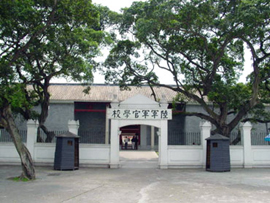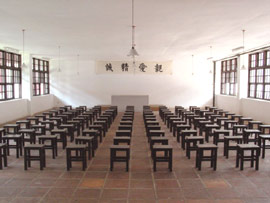
|
Revolution in the Making |
|
|
|
|
|
|
|
|
|
|
|

The Whampoa Military Academy (today known as the Huangpu Military Academy)
was founded as the West Point of the East during the Russian intervention
to help spur military movement’s during the Sun Yat-Sen’s Revolution.
The academy served as China's premier choice for her officer traininig
corps. Generals from World War II credited the superior training
of Whampoa for their success. Today it still remains a bright token
of pride and accomplishment to the Chinese Military.
October 10, 1911, the Qing Dynasty of China fell. Sun Yat Sen, an intellectual leader tried to devise two revolutions against the Qing in order to establish a Republican government. Although never successful in any of his revolutions, he opened the door and made China aware of its immanent future.
The Soviet Union, having had a successful “Marxist” revolution, started the process of Comintern. They wanted the knowledge of Marxism and Leninism to spread. The creation of Comintern would do just that. Sending delegates to interested countries would spread Marx’s ideas, which were necessary to fulfill his idea of the entire world proletariat revolting.
Sun Yat Sen also opened the door for Chang Kai-Shek who would later
lead a successful revolution, much along the Taiping fashion. Once
the Communists saw that the door had been unlocked they planned on killing
Chang Kai-Shek and taking over his accomplishments for their own government.
Weary of this, Chang started the White Terror, thereby killing nearly 80%
of
all communists in the country, but the communists would get their revenge.
 Chiang Kai-Shek
was the son wine merchant, who thrived a bit from the foreign influence
in Canton. Chiang grew up in the small town of Chikow in Chekiang
province. He was set up to be married when he was just fourteen years
old. Although he had never met his bride, they wed following Chinese tradition.
Once home he tried to keep his mind off of the marriage and concentrated
more on what kind of man he wanted to become. The military had always
interested him and he dreamed of becoming a soldier. He saw glory in the
military and felt comfortable with the demand for discipline, strength
and courage. His family wanted him to study law, but despite their
pleas he left for the Tokyo Military Staff College in 1907.
Chiang Kai-Shek
was the son wine merchant, who thrived a bit from the foreign influence
in Canton. Chiang grew up in the small town of Chikow in Chekiang
province. He was set up to be married when he was just fourteen years
old. Although he had never met his bride, they wed following Chinese tradition.
Once home he tried to keep his mind off of the marriage and concentrated
more on what kind of man he wanted to become. The military had always
interested him and he dreamed of becoming a soldier. He saw glory in the
military and felt comfortable with the demand for discipline, strength
and courage. His family wanted him to study law, but despite their
pleas he left for the Tokyo Military Staff College in 1907.
Dr. Sun Yat-sen, a teacher there, soon became a good friend and mentor for Chiang. Sun was born near Guangzhou and attended an Anglican boys school in Honolulu. Here he learned western teaching and more importantly, Christianity. He received a diploma from a Hong Kong medical school, although he practiced medicine for a while, he grew tired of the Qing Dynasty and soon focused his life on establishing a stable Chinese republic.
Sun Yat Sen tried two unsuccessful revolutions. When he fled China
for protection he fell into the western teachings of Karl Marx and Henry
George and was enthralled. Sun organized a revolutionary league, the Tung
Meng Hui, in Japan and gradually perfected his political conceptions, which
were based on the Three People's Principles: nationalism, democracy, and
the
people's livelihood. Revolution erupted in China, and Sun was elected
provisional president of the Chinese republic in December 1911, but later
he resigned in favor of Yuan Shikai. Later, when Sung Chiao-Jen transformed
the Tung Meng Hui into a political party called the Kuomintang (KMT), Sun
served as its director.
Chiang Kai Shek quickly became involved with Sun’s revolts that helped establish the Chinese Republic. When Sun was unsuccessful, Chiang started his own revolt, which turned out to be successful. In 1917 when Sun established the Guangzhou government, Chiang was his military aide. Sun sent him to the Soviet Union to study Russia military methods. The Russians having had a successful “Leninist” revolution wanted to spread the Marxist ideas. Through the Comintern process they gave Chiang advice and also sent military advisors to help.
One of these men, named Michael Borodin suggested that they start a
military academy in China. They placed it in Whampoa and named it
the Whampoa Military Academy. Much like the academies of Russia and
the United States it was designed to inspire nationalism and earn respect.
Once opened they received 1,500 applicants. It planned to register only
300.
During the opening of the Whampoa Military Academy, the words of the
ROC national anthem were first delivered on June 16, 1924, by Dr. Sun Yat-sen.
It was designated as the Kuomintang's (KMT) party song in 1928.
 In the late
1920s and early 1930s, the Ministry of Education held two separate competitions
for lyrics for a national anthem, using the KMT party song in the meantime
as a temporary national anthem and was finally adopted as the official
national anthem of the Republic of China in 1937. The anthem declares
the Three Principles of the People to be the foundation of the nation and
guides to a world commonwealth of peace and harmony; and then calls upon
the people to be brave, earnest and constant in striving to fulfill the
nation's goals.
In the late
1920s and early 1930s, the Ministry of Education held two separate competitions
for lyrics for a national anthem, using the KMT party song in the meantime
as a temporary national anthem and was finally adopted as the official
national anthem of the Republic of China in 1937. The anthem declares
the Three Principles of the People to be the foundation of the nation and
guides to a world commonwealth of peace and harmony; and then calls upon
the people to be brave, earnest and constant in striving to fulfill the
nation's goals.
The Whampoa Military Academy, for the Officers of the Army School, was a new type of military and political school which was established in 1924 by Sun Yat-sen, with the help of the Russian and Chinese Communist Parties. The island that it's on is 6 square kilometers. The island is covered with rivers, hills. The island became the military fortress of Changzhou.
Although its location has changed, the name of the school has always been the Whampoa Military Academy. The “West Point of the East,” Whampoa has produced some very famous officers in large numbers. They were well known for their brilliant achievement in war. It became one of the four largest Military Schools in the world and it has historic significance in Chinese modern history and military history.
The School's Basic Department faces the Pearl River, and is built against the Zhiqi Mountains. Behind the first and the second entrance is a building which was an Army school dormitory in the Qing Dynasty. When the military school was originally opened, it had to be repaired slightly. The school had to move to Nanjing in 1930. The Basic Department was blown up by Japanese fighters in 1938. After Guangzhou was occupied, the Japanese army was stationed here and it was further destroyed. Following World War II many things changed. In 1996, the Changzhou Cultural and Tourist Scenery Exploring and Constructing Group, led by the Guangzhou Government, decided to re-build the Basic Department.
The foundations were laid on 16th June, and it was re-built according to the rules of the State Bureau of Cultural Relics: the original location, the original area, and the original outlook. It was completed on 12th November in the same year, and covered 10,600 square meters, costing over 20,000,000 yuan to build. The Basic Department reproduced the offices of Sun Yat-Sen, Chiang Kai-Shek and Liao Zhongkai, and Chou En-Lai's Political Department office. They also rebuilt classrooms, the mess halls and accommodation halls.
The Sun Yat-Sen Memorial Hall (the former residence of Sun Yat-Sen) used to be the offices of the Whampoa branch of the Guangdong Customs, in the Qing Dynasty. Sun Yat Sen established the military academy in 1924 and in 1926, the building was changed into a military barracks and a memorial hall to the Premier.
In Zhongshan Park, there are several pavilions and stele with the signatures
of some of the military academy's teachers and students. The Sun
Yat-Sen Monument is located on Bagua Mountain in Zhongshan Park. It was
built by contributions made by the teachers and students to commemorate
Sun Yat-Sen. The foundation was laid in 1928 and the building completed
on
September 26th, 1930.
The monument looks like a Chinese character "Wen" (Sun Yat-Sen's Chinese
name). To the north of the base of the monument, on a platform, are 4 large
inlaid characters, "closing, loving, perfect and honest", which were Sun
Yat-Sen's instructions. In the center there is a large statue of
Sun Yat-Sen. The statue was made by Muyou Xiangyou, and cast by the Youyan
Jinzuo Factory. Meiwu Zhuangji transported the copper statue to Guangzhou
in May 1930. The front of the
monument is engraved with six characters in Li writing: the Sun Yat-Sen
monument. On its eastern face are some of his teachings on the deceased.
On the western side are some of his instructions on schooling, and on the
back are words in praise of Sun Yat-Sen.
The Whampoa Military Academy is truly an important fixture of Chinese
History. The academy not only has produced some of the most world
renown military leaders in history, it is a stepping stone of Russian and
thus communist influence on China. Having had Mikhail Borodin help
setup the school is but a pebble in the rock to come of Soviet Influence
in the communist realm. Even today it plays an active role in the training
and development of Chinese military leaders.
S.C. Long and N.D. Palmer. Sun Yat Sen and Communism.
(1960.)
H. Schiffrim. Sun Yat Sen and The Origins of the Chinese Revolution.
(1970.)
M. Wilbur. Sun Yat Sen. (1977.)
Chiang Kai-Shek. China’s Destiny. (1947.)
P. Lah. The Early Chiang Kai-Shek. (1971.)
S. Dolan. Chiang Kai-Shek. (1988.)
H. Isaacs. The Tragedy of the Chinese Revolution.
www.roc-taiwan.hk/ota/china_attraction/cn_huangpu/e_huangpu.htm An explanation of the Chinese National Anthem and its foundations.
library.thinkquest.org/26469/movers-and-shakers/chiang.html A brief history of Chiang Kai Shek
www.marx2mao.org A history and collection of writings from various historical writers, including figures important to Whampoa.
peacock.tnjc.edu.tw/index/ADD/TENS/DRSUN.html
A brief history of Sun Yat Sen